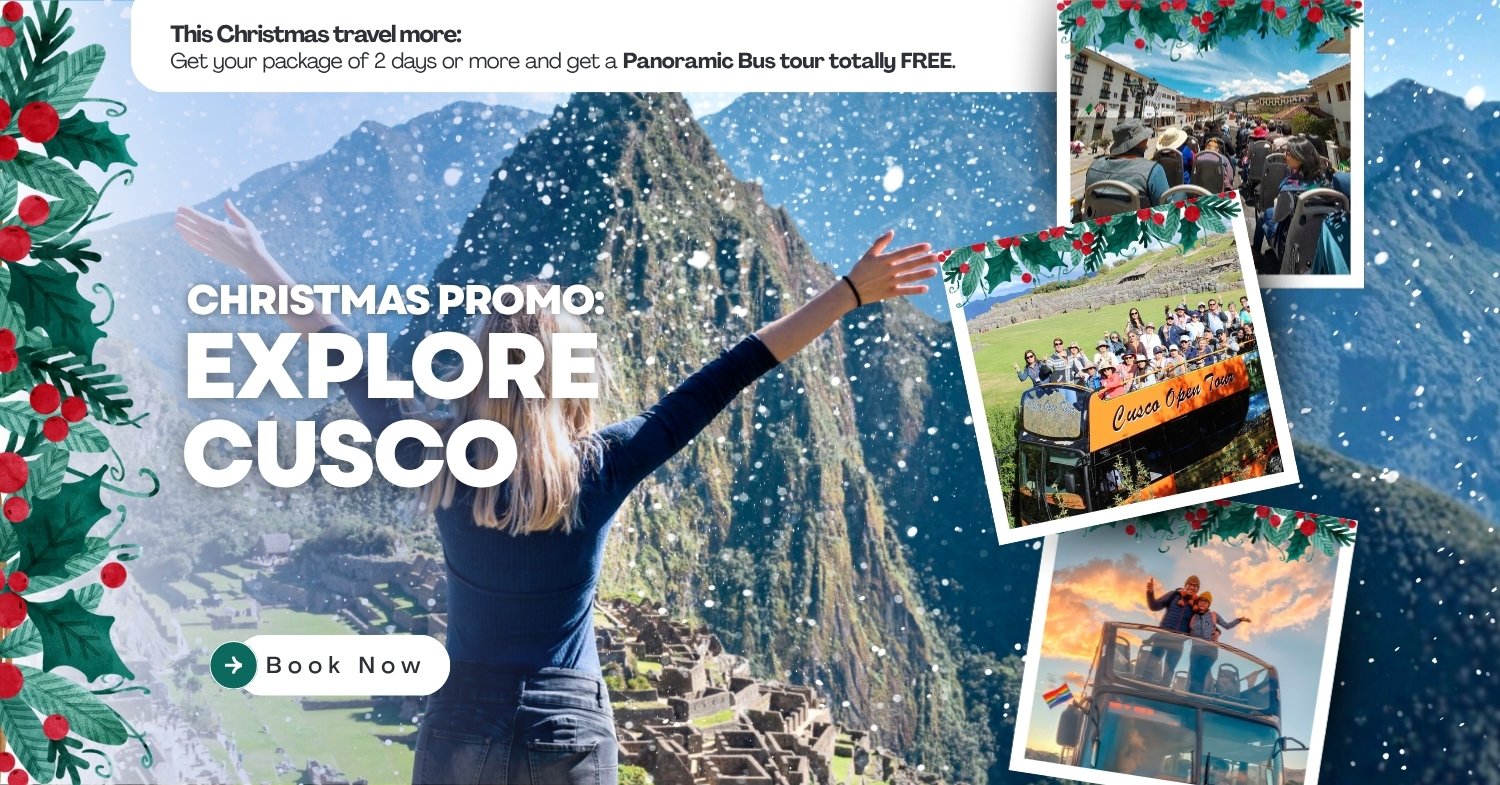

When you look for tours to visit the Inca citadel of Machu Picchu, you will see a variety of possibilities; from quick 1-day trips to traditional tours that involve famous archaeological centers, arriving by train or through famous hikes like the 4 Day Inca Trail.
However, if you are interested in completing the route to Machu Picchu without spending too much money, or maybe you did not manage to get a coveted ticket for the Inca Trail, we offer you two great alternatives that represent the spirit of the Adventure in Peru: the Lares Trek and the Salkantay Trek. Both are spectacular options for Peruvian Highland trek, walking through valleys, plains, and mountains.
Many people wonder which is the best alternative to the Inca Trail, with some leaning towards the Lares Trek and others towards the Salkantay Trek. In our opinion, both routes are excellent and offer different benefits. Here we explain the advantages and disadvantages of each route and their highlights, to help you make a decision about which of these epic hikes is the best option for you.
To be honest, most foreign visitors who come to Peru want to see the Inca city of Machu Picchu, and for this they want to hike the famous Inca Trail 4 days. But, because it is very popular, tickets for this trip sell out very fast; also, the rules that the Peruvian government put in place limit the number of people who can hike the Inca Trail to only 500 per day (counting guides and porters). Because of this, many travelers choose other options like the Salkantay or Lares trek. But, which of these two routes is best for you? Below, we tell you the details of each one so you can choose the adventure that best fits what you want.
The Salkantay Trek has become the second most popular route in the Peruvian Andes. With more visitors on the Inca Trail and the limits put in place by the government to protect this route (including a limit on the number of hikers per year), many local companies started to promote the Salkantay as the best option. This allowed this hike to become very popular compared to other routes to Machu Picchu.
The Salkantay route takes you through high mountain passes, reaching its highest point at the Salkantay Pass, located 4,650 meters (15,255 feet) above sea level. This is the highest and hardest part of the trip, where you walk at the foot of the Salkantay mountain, a sacred mountain for the Incas that rises to 6,271 meters (20,574 feet). The trail goes through snowy peaks before going down into the green Andean jungle, to less than 1,000 m above sea level.
This journey offers amazing scenery and the chance to add extra experiences at the end of the trip, like exploring old Inca ruins or going on an exciting zipline. The hike is only done during the dry season (from April to October), because during the rainy months (November to March) the risk of landslides makes it dangerous.
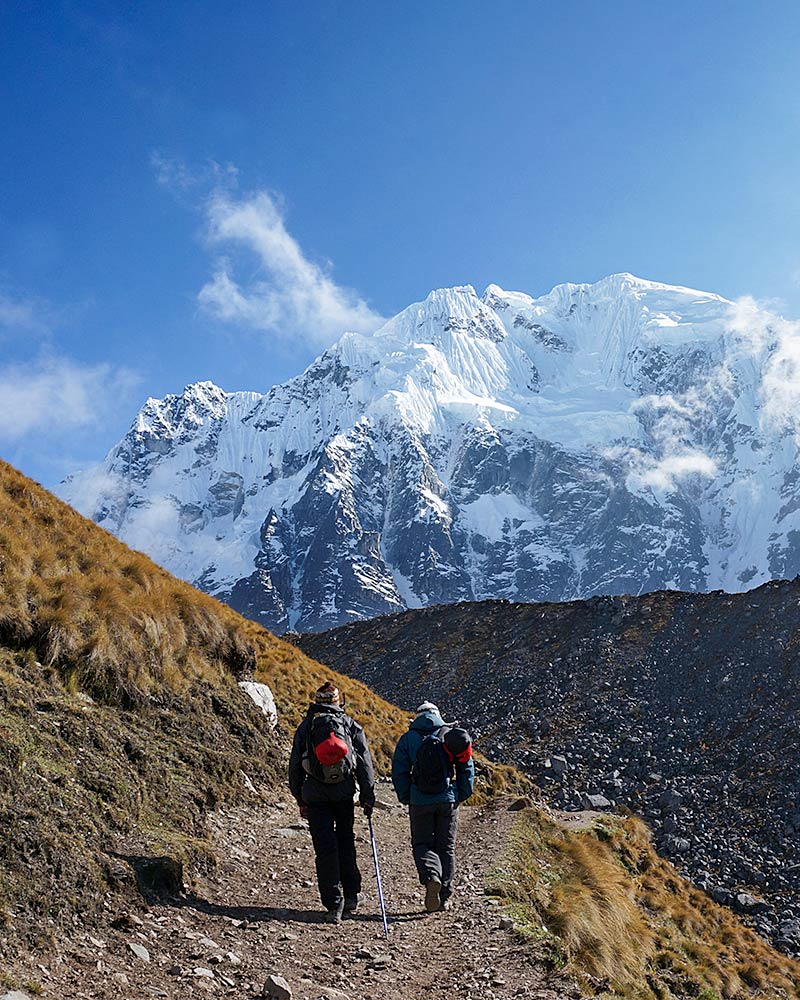 | 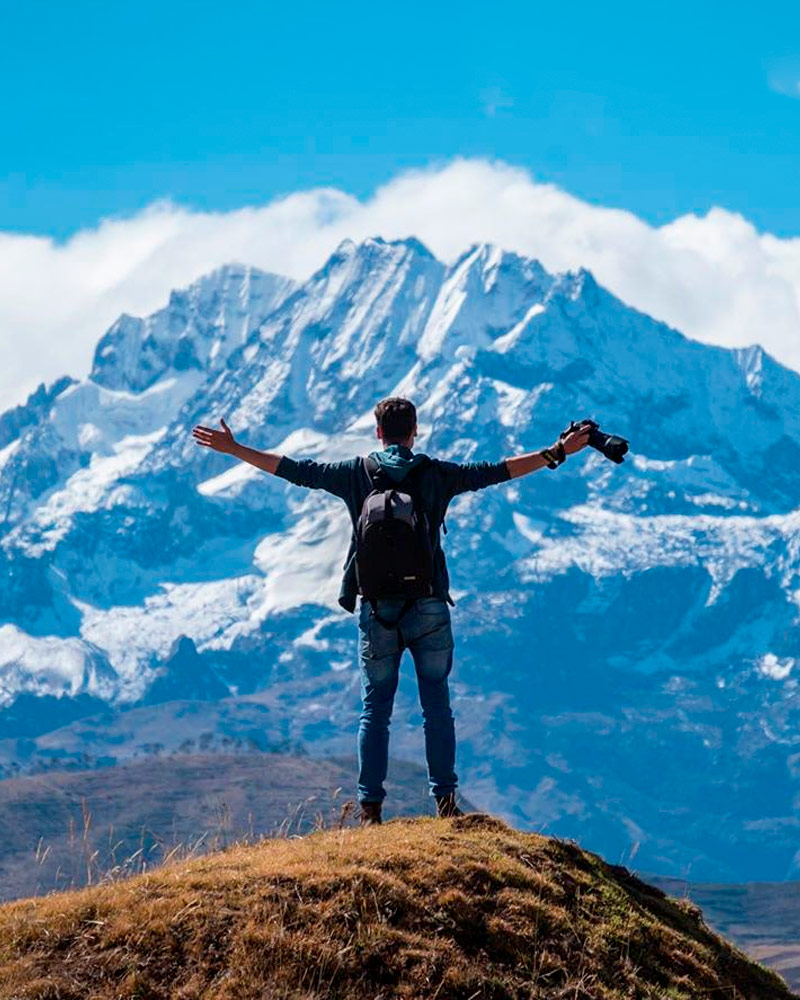 | 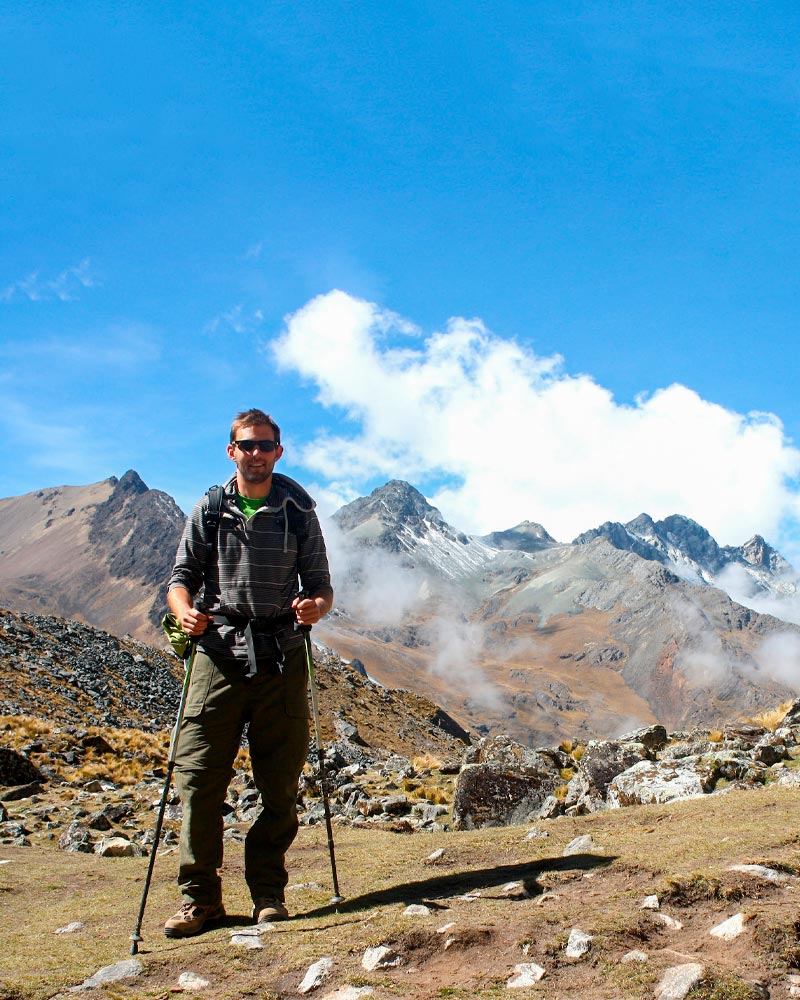 |
Another great choice to get to Machu Picchu is the hike through the Lares Valley, located on the east side of the Urubamba mountain range, with access through the famous Sacred Valley of the Incas. Even though it's known as a great option instead of the Inca Trail, this route is much less crowded. This lets you enjoy a quieter and more real experience. In fact, on many parts of the trail, you can walk for hours without seeing other hikers.
The hike through the Lares Valley offers a unique journey through beautiful scenery, crystal-clear lakes, and wide views of the Andes. Depending on the route you choose, the trip can start or end with a relaxing visit to the Lares hot springs.
One of the most rewarding parts of this route is the cultural interaction it offers. Unlike other busier hikes, the Lares trek goes through small country communities where the people, who speak Quechua, keep their traditions alive. These towns keep a farming way of life based on methods passed down from their ancestors, and they are especially known for their textile art. It's common to see women dressed in typical clothes spinning with spindles or weaving on waist looms, a living showing of the Andean cultural identity.
Unlike the Inca Trail, the Lares hike doesn't go directly to Machu Picchu on foot. Instead, the route ends with a train ride from Ollantaytambo to Aguas Calientes, the base town for visiting the Inca city. This lets you mix the cultural and natural trekking with the unforgettable experience of exploring Machu Picchu Peru.
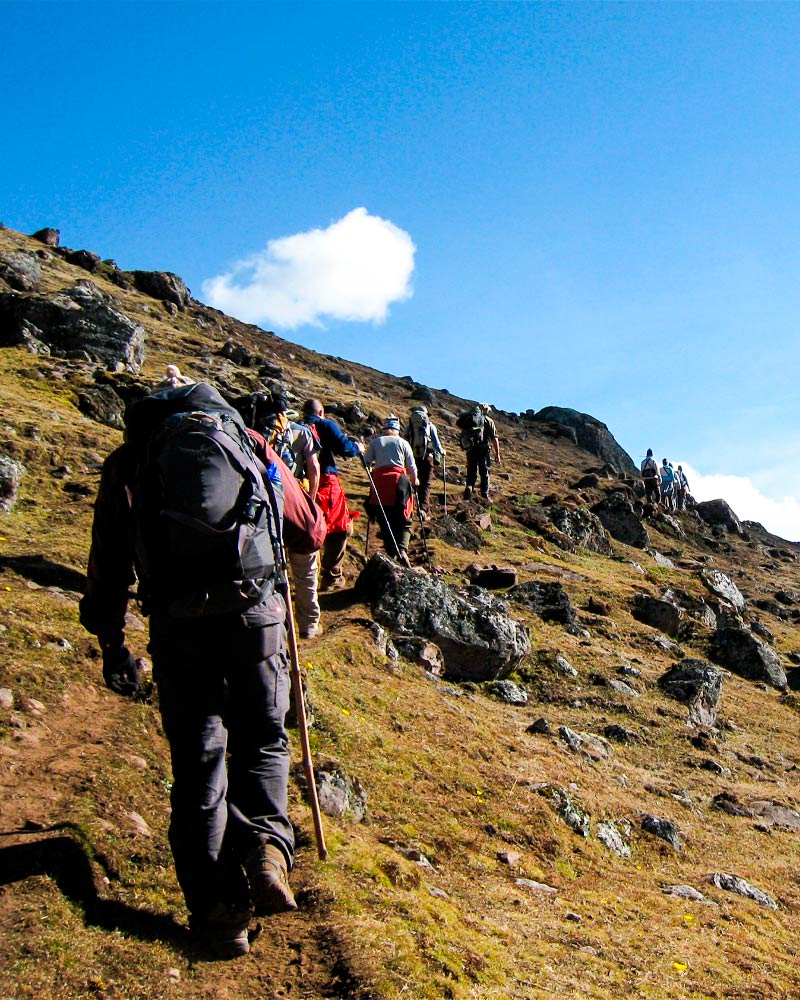 | 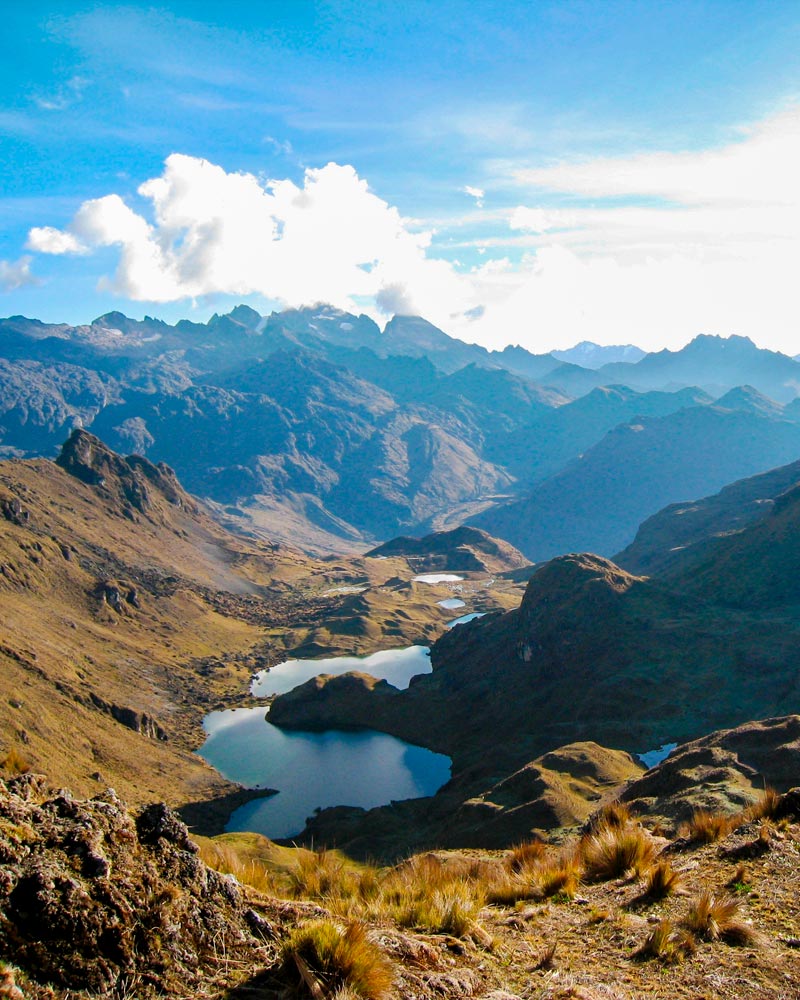 | 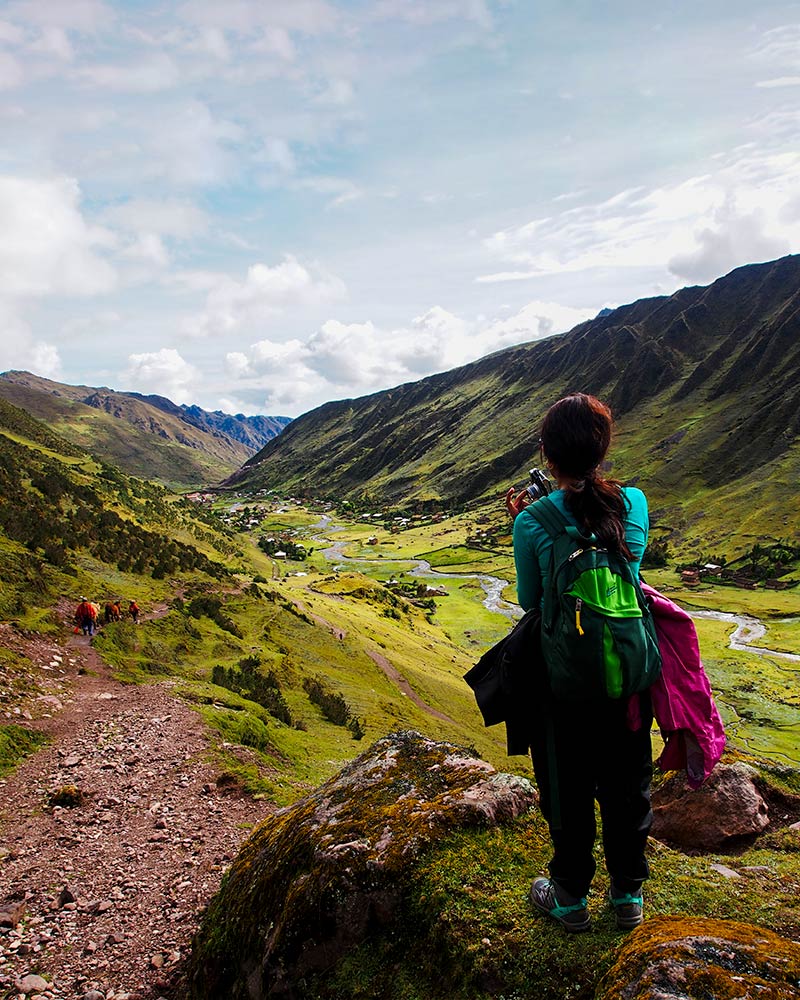 |
Aspect | Salkantay Trek | Lares Trek |
Difficulty Level | Hard. Best for hikers in good physical shape looking for a significant physical challenge. | Medium. Suitable for those who want a more relaxed and manageable hike, without missing out on the adventure experience. |
Focus of the Tour | Focused on nature and the physical challenge. The route stands out for its variety of landscapes, from snowy mountains to tropical forests. | Focused on cultural immersion. Offers the chance to interact with Quechua communities and learn about their traditional way of life. |
Landscapes | Impressive variety: glaciers, snowy peaks, high-altitude lakes, and a change towards high jungle. | Green valleys, Andean lakes, and wide views of the Andes, with a more peaceful setting less touched by tourism. |
Tourist Crowds | Regular Crowds. Being one of the most popular alternative routes to the Inca Trail, you might find several groups of hikers along the way. | Fewer Crowds. Perfect for those looking for peace and a more personal experience with nature and local culture. |
Aspect | Salkantay Trek | Lares Trek |
Importance | It is one of the most famous routes to Machu Picchu, known for its amazing landscapes. It goes through snowy mountains, jungles, and Inca ruins. | Less crowded, it offers a calm and cultural experience, with rural landscapes and Andean communities that keep an old way of life. |
Location | It is located in the Vilcabamba mountain range, about 37 miles north of Cusco. | It is in the eastern mountain range of the Central Andes, in the Lares district, Calca province, Cusco. |
Maximum Altitude | It reaches up to 15,200 feet above sea level, crossing high passes in the Andes. | It goes slightly higher than Salkantay, with a maximum altitude of 15,580 feet above sea level. |
Estimated Time | It usually lasts 5 days, although it can change depending on the tour plan. | It has a flexible length of up to 5 days, depending on the tour you choose. |
Best Season | April to November is the best time, although you can go in March and December carefully because of heavy rains. | It is open all year, and although it rains in the wet season, the path is still usually safe and quiet. |
Aspect | Salkantay Trek | Lares Trek |
Landscapes | It offers an amazing variety: from high snowy mountains to lush tropical forests. The route includes wide views of the Salkantay snow-capped mountain and the Humantay lagoon. | Traditional Andean landscapes are common, with clear lakes, green valleys, and majestic mountains. The route lets you really see Andean rural life. |
Physical Difficulty | Considered harder because of its altitude and different terrains. You need to be in good physical shape to handle days of up to 8 hours of walking. | Medium difficulty, although it reaches higher altitudes than Salkantay. The days are usually 7 hours, making it easier for those looking for a less demanding experience. |
Cultural Interaction | Less interaction with local communities, focusing more on nature and landscapes. | High interaction with Quechua communities, letting you learn about their traditions, weavings, and old way of life. |
Hot Springs | It includes a stop at the Cocalmayo hot springs, perfect for relaxing after the walks. | It visits the Lares hot springs, perfect for resting and enjoying the natural surroundings. |
Access to Machu Picchu | The route lets you walk to Aguas Calientes, passing through archaeological sites like Llaqtapata. | After the walk, you take a train from Ollantaytambo to Aguas Calientes to get to Machu Picchu. |
Lares Trek: This route begins in the city of Cusco where the tourist bus goes through the Sacred Valley until Calca town. Then visit the famous relaxing and healing thermal waters of Lares. After this excursion begins the climb which highest point is at 4 400 m.a.s.l.
The trek continues through communities such as Patacancha and then descent to the town of Ollantaytambo Peru from where you will have to board the train towards Aguas Calientes and finally visit the Machu Picchu ruins.
Salkantay Trek: The journey begins in the city of Cusco then continues in the Limatambo Valley until Mollepata zone where trek will start, during the trek the ascent will reach 4 600 m.a.s.l. through the Apu Salkantay pass. Later on you will descend to the peruvian forest, and then to Machu Picchu.
The Salkantay trek is only available during dry season (April-October) as the chance of mudslides makes it dangerous to hike during rainy season (November-March).
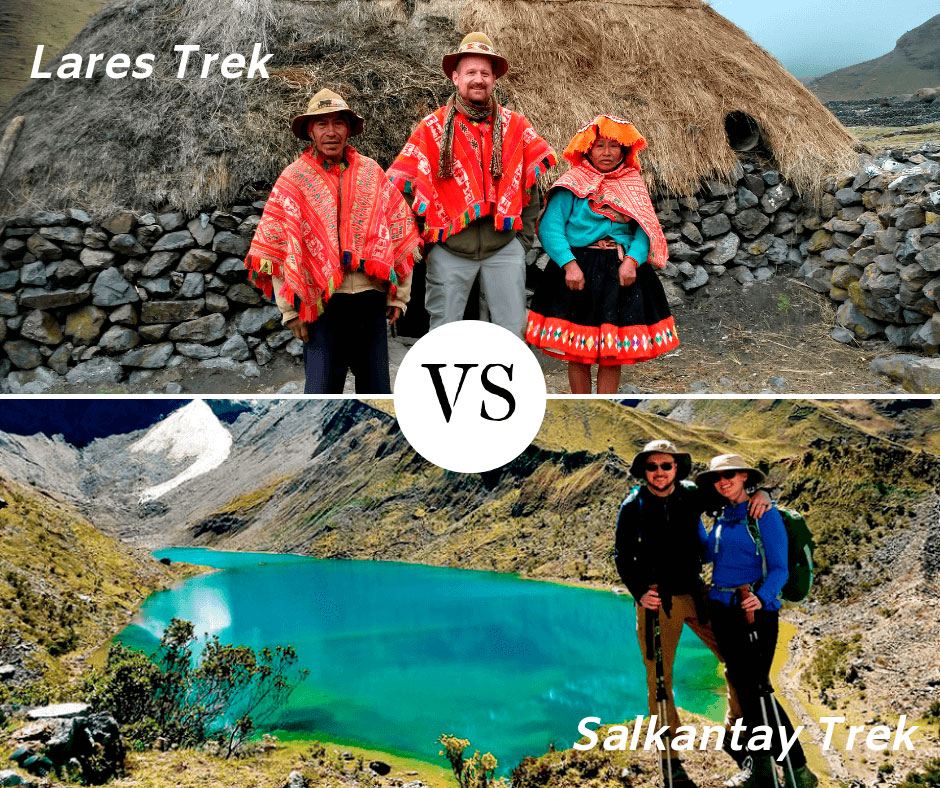
RELATED:INCA TRAIL vs SALKANTAY TREK
Lares Trek:Lares Trek camping is much less regulated, meaning there’s a lack of facilities after the first night in a campsite near small settlements, where local people are happy to see you and offer a small slice of village life.
The campsites on the Lares Trek basic have fitted toilet and shower blocks. If you aren't a fan of freezing first thing in the morning, I'd recommend washing with the warm water bowls the provided in the morning. Oh, and a word to the wise: on the Lares Trek to Machu Picchu, wet wipes are your best friend.
Don't make the mistake of skimping on the gear; these mountains are cold. If you don't have a four-season sleeping bag, rent one.
Salkantay Trek: Camping on the Salkantay trek is fully supportedand is set amidst the amazing backdrop of the Andes' Vilcabamba range.
Along the way there are various accommodation/camping options where it is possible to break up the descent You can opt to camp or stay in lodges along this route. The camping trek is comfortable, with thick sleeping mats. A difference between camping on Salkantay Trek vs Lares Trek is that on Salkantay not as crowded and not everyone stays at the same campsites on a set schedule.
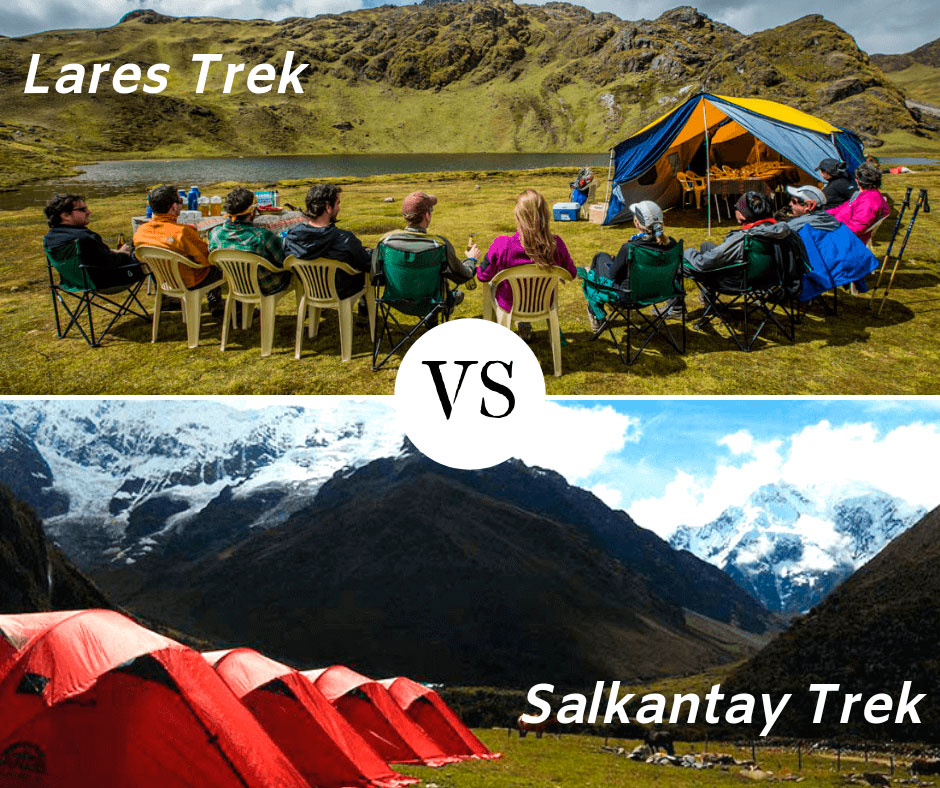
Lares Trek: During all journey you will be surrounded by mountains such as the snow peak Apu Ausangate as well as the flora and fauna of the Peruvian Andes. On the way you can see crystalline water lakes and visit communities that still keep their original traditions making of this journey an unforgettable experience, since you could live with the local population and learn a bit more of their customs.
Salkantay Trek: The Salkantay trek takes you over soaring mountain passes (located at an altitude of 4600m / 15,092 ft), passed snow-capped peaks, and down into the Andean jungle at just about 1000m above sea level. It’s an incredible journey through changing scenery, with additional options near the end to hike up to see Incan ruins or even take a thrilling ride on a zipline.
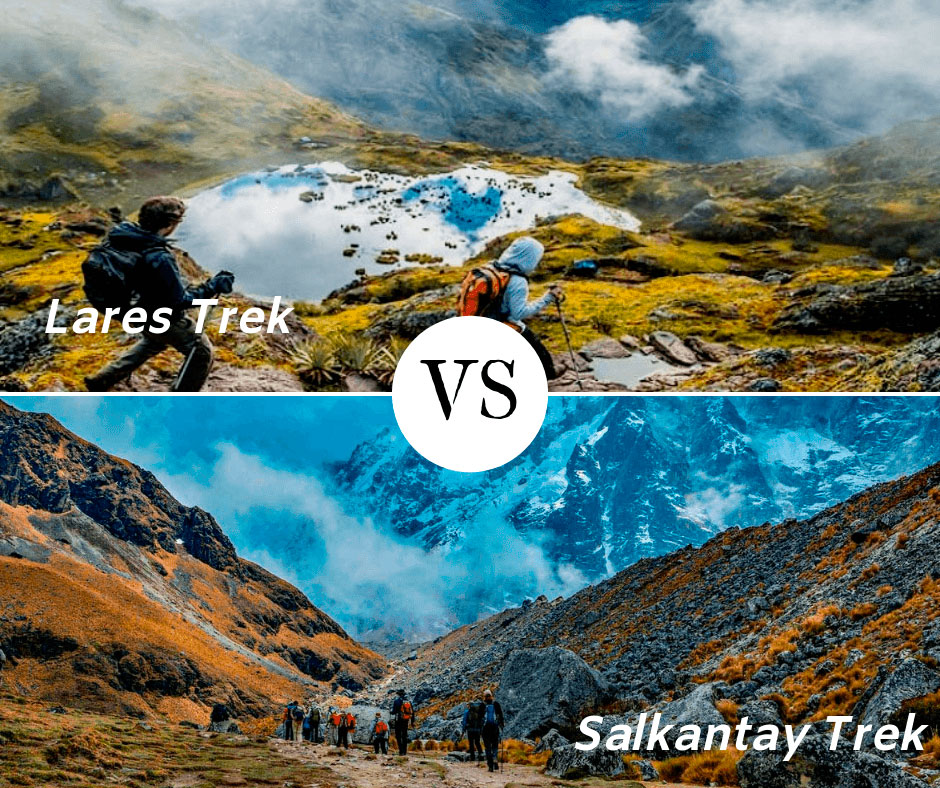
The experience itself is difficult to compare between Lares Trek vs Salkantay Trek. The one thing in common on both of the treks is the exceptional level of service that you receive including full-service camping, with three meals a day and plenty of snacks and water. All of the trekking equipment is in excellent condition, and can be easily hired for both routes. In both after the trek, you continue to Aguas Calientes and spend the night in a hotel in comfort, before ascending to Machu Picchu the next morning.
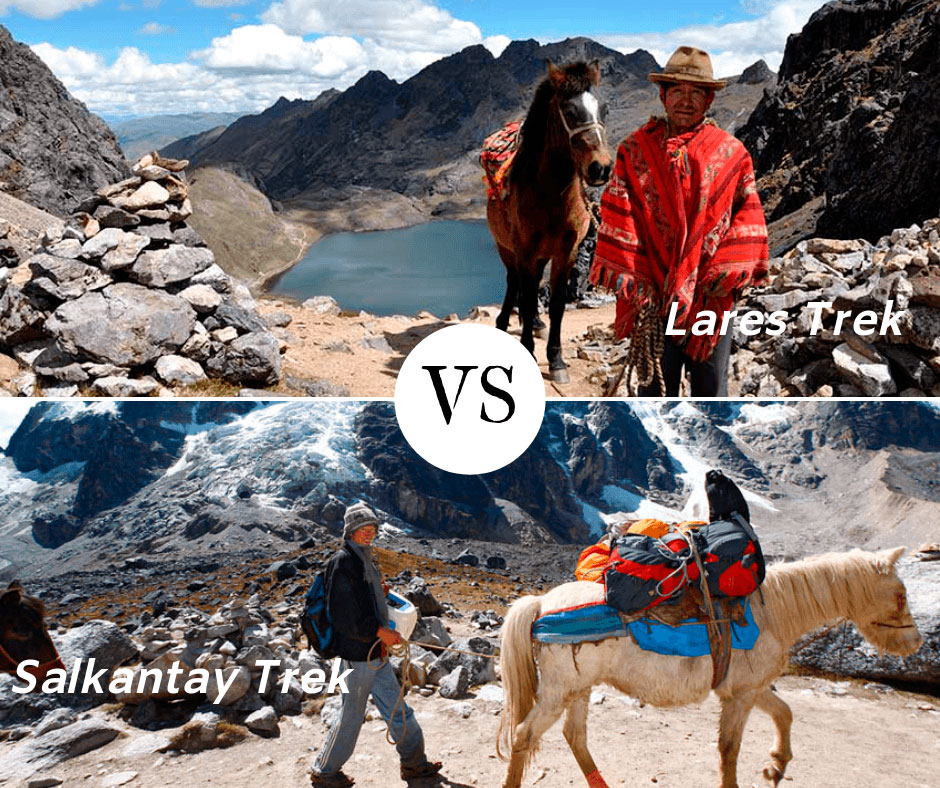
RELATED: INCA TRAIL vs LARES TREK
Salkantay Trek | Lares Trek | |
Difficulty | Moderate - challenging | Moderate |
Duration | Salkantay Trek 4 days, 5 days, or Salkantay 3 day trek | Lares Trek 4 days |
Remoteness | Fairly remote with less trekkers | Passes through villages |
Maximum altitudes | 4,600 m | 4,450 m |
Accommodation | Camping | Camping |
Best seasons | April-November | May – October |
Start / End Locations | Cusco-Mollepata / Aguas Calientes-Machu Picchu | Cusco / Aguas Calientes-Cusco |
Permit required | None | None |
Thermal Baths | Optional hot springs in Aguas Calientes | Includes a break at the hot springs of Lares |
Physical fitness | Average | Average |
In our humble opinion, both treks are great and have different things to offer. When comparing the Lares trek vs. the Salkantay Trek, the ultimate decision will depend upon your preference of a experiential tourism or something more original. If you want to catch spectacular views of lagoons, impressive snow-capped mountains such Salkantay and Humantay, rivers and subtropical zones full of flora and fauna, then you should choose the Salkantay Trek. If you are willing to forgo this experience in return for a more novel and authentic trekking experience, the beautiful and lesser-known Lares trek is a good option.
Machu Picchu, one of the 7 wonders of the modern world, is not only a place you must see, but also the end point of several hiking paths that go through amazing scenery, forests, and old Inca roads. For those who want hard adventures or easy trails, there are different ways to get to this wonder without counting the Salkantay and Lares walks.
Each path is a different experience that shows a different side of the Inca history and the amazing nature around Machu Picchu. Whether you are walking on old stone roads, visiting old sites, or exploring less traveled paths, the trip is as memorable as the place where your adventure ends.
Learn about the ways to get to Machu Picchu: